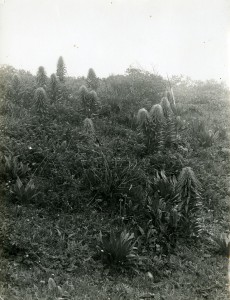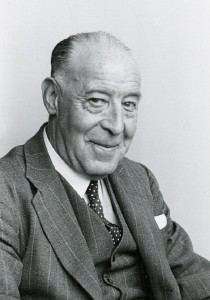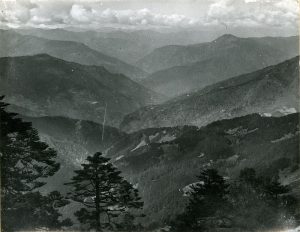Roland Edgar Cooper was born in 1890 and orphaned at an early age. Once he turned sixteen he came under the guardianship of his aunt Emma Smith, his mother’s half-sister, and her husband, the botanist and future Regius Keeper at RBGE, William Wright Smith.
In 1907 Cooper went to India with his uncle when Smith became Keeper of the Herbarium at the Royal Botanic Garden Calcutta. While in Calcutta, and then later in Lloyd Botanic Garden Darjeeling, Cooper studied botany and horticulture under the tutelage of George Thomas Lane, the then Curator of the Royal Botanic Garden Calcutta. While in India he accompanied his uncle on collecting trips to Sikkim and the borders of Nepal, Bhutan and Tibet, gaining early experience of the diversity of the Himalaya.
Cooper returned to Scotland in 1910 when Smith was offered a post at RBGE to describe the extensive collections then being received from George Forrest from Yunnan. Cooper’s botanical and horticultural education continued when he signed up to be tutored at the Garden by Isaac Bayley Balfour with the intention of becoming a fruit farmer in British Columbia.
Before finishing his studies he took up a post leading a collecting expedition to Sikkim sponsored by A.K. Bulley of Ness Gardens, with encouragement and support from Smith and Balfour. From his early expeditions to Sikkim, and his studies at RBGE, Cooper was well qualified for this task. The reference that Balfour wrote for Cooper to Bulley sang his praises, citing that he had a good grasp of local Northern Indian dialects and an aptitude for learning languages.
Collecting Trips
Cooper’s collecting trips to Sikkim (1913) Bhutan (1914 & 1915) and finally to the Punjab (in an area now part of Himachal Pradesh) (1916) and later in Burma (1921-22) saw Cooper collect about 6100 numbers. He paid tribute to his team of Lepcha collectors, headed by Rhomoo Lepcha, whom he said contributed greatly to the sucess of his trips.
His collections in Bhutan were some of the earliest from the country and served as an importance resource in the writing of the Flora of Bhutan. Many of his specimens at Edinburgh have been databased and digitised. A few also have associated field images such as Lobelia nubigena. Unfortunately most of Cooper’s early and pioneering images from Bhutan now appear to be lost.
For further information on Cooper’s Bhutanese itineraries see: Long, D.G. 1979 The Bhutanese Itineraries of William Griffith and R.E. Cooper, Notes from the Royal Botanic Garden Edinburgh Vol.37(2): 355-368
The Great War (1916–1918)

Cooper cut short his 1916 trip in N.W. India and was commissioned as Lieutenant Roland Edgar Cooper in the Indian Army Reserve of Officers, serving initially with the 1st Reserve Ghurkha Rifles on the North West Frontier of India (now in Pakistan). He was later seconded to the 4/3rd Ghurkha Rifles attached to the Royal Flying Corp. and transferred to Alexandria, Egypt, and remained in service there until 1919.
Rangoon (1921–1930)
In 1921, Cooper was appointed by the India Office to be Superintendent of Myamo Botanic Garden in the Shan Hills of Burma; he was the first British-trained officer to hold the post. Cooper also carried out work for the Rangoon Development Trust helping to transfer the Agri-Horticultural Society of Burma to a new site in Rangoon. Once this was completed, he resigned his post with the Government and took up a post with the Society. His trips and collections to the islolated peak of Mt. Victoria served to highlight some of the endemic flora of that mountain.
Edinburgh (1930-1950)
In 1930 Cooper returned to Edinburgh with his family so that his son could benefit from a Scottish education. Cooper’s first job on returning to Scotland was to lay out the grounds of the Astley Ainslie Hospital in Edinburgh for its official opening. He then rejoined the RBGE as an Assistant Curator and later, in 1934, became Curator; a post he held until his retirement in 1950. During this time he oversaw the redevelopment of the Rock, Peat and Heath Gardens, as well as the renovation of the Woodland Garden.
During 1931–32 Cooper donated his ethno-anthropological artefacts from Bhutan to the National Museum of Scotland. This donation included: silk scarves, money pouches and coins, prayer flags, a lama’s tiara, saddlebags and a dress. Also, and most impressively, three daggers and a sword that had been given to Cooper by Ugyen Wangchuk, the first King (known by the British as Maharaja) of Bhutan, in 1915.
Cooper with several members of staff and a number of others founded the Scottish Rock Garden Club in 1933.
For a fuller article on R.E. Cooper see the SRGC site here.
The RBGE Library Archive hold Cooper’s notebooks, maps and manuscripts. For a list see here
Living Collection
A handful of Cooper’s original plants still grow in the Living Collections across the four gardens.
Botanical Commemoration
Cooper is remembered through a number of botanical comemorations a number appear still to be valid.
Anaphalis cooperi Grierson & Spring. Edinburgh J. Bot. 57(3): 397 (2000). (ASTERACEAE). Bhutan, Timphu, Parshong [Thimphu District Barshong], 12,500ft, 27 vii 1914, Cooper 1955 (Holotype E, Isotype BM)
Berberis cooperi Ahrendt Gard. Chron. ser. 3, cix. 100 (1941). ; and in Journ. Bot., Lond. lxxix.Suppl., 61 (1941). (BERBERIDACEAE). Bhutan 1914 Cooper 2979 (Holotype? ) [This plant was described from living plants at Glasnevin and in the author’s garden. Herbarium specimens of the cultivated plants grown from Cooper 2979 (E).]
Buddleja cooperi W.W.Sm. Notes Roy. Bot. Gard. Edinburgh 10: 14. 1917. (LOGANIACEAE). Bhutan, Rudung La and Pumthang, 11,000ft, 23 vii 1915. Cooper 4154 (Holotype E)
= Buddleja forrestii Diels
Didissandra cooperi Craib. Notes Roy. Bot. Gard. Edinburgh 11: 241. 1920 (GESNERIACEAE). Bhutan. Dotena Timphu, 8000ft. Cooper 2508/a. (Type unspecified E)
= Corallodiscus cooperi (Craib) B.L.Burtt.
Cotoneaster cooperi C.Marquand, Hooker’s Icon. Pl. 32: t. 3146. (1930). (ROSACEAE)
Delphinium cooperi Munz J. Arnold Arbor. xlix. 132 (1968) (RANUNCULACEAE). Bhutan, Tsonga, 3 x 1914. Cooper 2294. (Holotype E)
Lactuca cooperi J.Anthony. Notes Roy. Bot. Gard. Edinburgh 18: 198. (1934). (ASTERACEAE). India, Sikkim, Kapup. 13,000ft. ix 1913. Cooper 793. (Holotype E)
= Youngia depressa (Hook.f. & Thomson) Babc. & Stebbins
Lalldhwojia cooperi Farille, Rev. Gén. Bot. 91(1076-78): 31 (1984) (APIACEAE). India, Sikkim, on border with Bhutan. 1 ix 1913. Cooper 772 (Holotype E, Isotype E)
= Lalldhwojia staintonii Farille
Parnassia cooperi W.E.Evans, Notes Roy. Bot. Gard. Edinburgh 13: 172. 1921. (PARNASSIACEAE). India, Sikkim, above Toong 10,000ft, 19 ix 1913 Cooper 907. (Holotype E)
Pedicularis cooperi P.C.Tsoong, Kew Bull. 1954, 450 (1954). (OROBANCHACEAE) India, Sikkim, Chola Pass 14,000ft, 16 viii 1913. Cooper 884. (Holotype E & Isotype E)
Poa cooperi Noltie, Edinburgh J. Bot. 57(2):283 (2000). (POACEAE). India, Sikkim Laghep, 10,000ft, 1 vii 1913. Cooper 118 (Holotype E).
Primula cooperi Balf.f., (PRIMULACEAE). India, Sikkim, above Toong, 10,000ft, 25 vii 1913. Cooper 349 (Holotype E)
Rhododendron cooperi Balf.f., Notes Roy. Bot. Gard. Edinburgh 10: 91. 1917. (ERICACEAE). Bhutan, Ridang, Angduphorang. 9000ft 8 vi 1915 Cooper 3959 & Bhutan, Vatola Ridge, Tsonga, 9000-10,000ft, 1 vii 1915. Cooper 4083. (Syntype E)
Rosa cooperi Hort., nom. invalid.
= Rosa cv. ‘Cooperi’ (Cooper’s Burma rose)
Other trade names: Rosa gigantea ‘Cooperi’, Rosa laevigata ‘Cooperi’, Rosa x cooperi, Rosa ‘Cooper’s Burma’, Rosa ‘Gigantea Cooperi’
The name Rosa cooperi, as far as I can tell, was never validly published in accordance with botanical nomenclatural rules – no description or preserved specimens cited. There are a number of references to this name relating to the plant in cultivation (Bunyard, 1938; Johnson, 1952; Cooper, 1953 & 1953a; Bean, 1981). There are no specimens of this preserved in the RBGE herbarium. The plant seems to be relatively generally available in the trade, with nine nurseries listed in the RHS Plant Finder as selling Cooper’s Rose.
Rubus cooperi D.G.Long, Notes Roy. Bot. Gard. Edinburgh 44(2): 259. (1987). (ROSACEAE). Bhutan, Mongar District, Sawang, 4 Aug 1915, 9000ft Cooper 4344 (Holotype E, Isotype BM).
Scrophularia cooperi R.R.Mill, Edinburgh J. Bot. 57(3): 424. 2000 (SCROPHULARIACEAE). Bhutan, [Thimphu/Phunakha districts: Dochung La]: Duké La, 8000ft, 17 Aug 1914, Cooper 3361 (Holotype BM, Isotype E).
Sedum cooperi Praeger J. Bot. 57: 49. (1919). (CRASSULACEAE). Bhutan 13,000ft. Cooper 3517. (Holotype ?).
= Rhodiola bupleuroides (Wall. ex Hook.f. & Thomson) S.H.Fu
Material for this name was based on living specimens that flowered in Glasnevin and in Praeger’s garden. There is a field collected specimen at E from the 3517 collection. However this name is a homonym of an earlier Sedum cooperi Clemenc published in 1868 and is therefore is therefore invalid. The replacement name to correct this mistake is Sedum bhutanicum Praeger

































































































